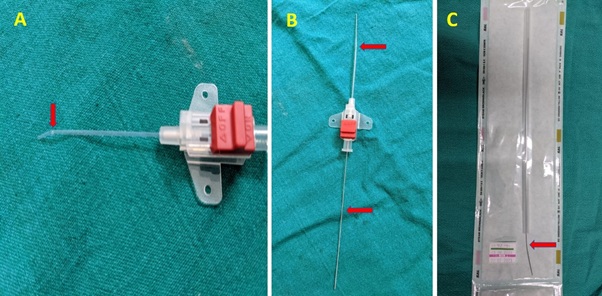
The troubleshooting arterial cannulation: A simple technique to succeed
*Corresponding Author(s):
Chitta Ranjan MohantyDepartment Of Trauma And Emergency, All India Institute Of Medical Science, Bhubaneswar, India
Email:drchitta8@gmail.com
Introduction
Sir,
Arterial cannulation is a frequently performed procedure among patients requiring accurate invasive hemodynamic monitoring or repeated blood gas analysis in the peri-operative and critical care settings [1,2]. The most employed techniques are the catheter-over-needle technique and the Seldinger technique.[1] The catheter-over-needle technique is basic, where the artery is accessed with a needle that includes an integrated catheter over it [1]. Although considered a relatively safe procedure when performed by a skilled practitioner, technical difficulties are often encountered even to most experienced hands [3,4]. We have suggested a simple technique to achieve success in case of difficulty in threading the catheter to artery in catheter-over-needle technique.
The threading of arterial cannula inside an arterial lumen is difficult due to kinking or damage to catheter tip in catheter-over-needle technique (Figure 1a) [3]. This mostly happens while trying to pass the catheter when it is outside the arterial lumen or after repeated attempts to cannulate the artery using the same arterial cannula. We used a straight guidewire (3 French, Arterial leader Cath, Vygon, India) to succeed with cannulation to solve the troubleshooting. In this technique, once the artery is accessed, the catheter is slightly withdrawn at the point where there is a free flow of blood. The guidewire is then passed through the catheter and advanced into the arterial lumen. Afterward, the catheter is placed into the lumen of the artery by feeding it over the guidewire. Then the free flow of blood is checked, the guidewire is removed, and the catheter is secured. In this technique, the guidewire helps the kinked catheter to straighten (Figure 1b) and act as a guide for successful cannulation. The straight guidewire can be sterilized with ethylene oxide and reused (figure 1c), especially in resource-limited settings [5]. We recommend this technique for troubleshooting arterial cannulation.
 Figure 1: (a) Kink in the arterial catheter (red arrow), (b) the catheter straightened (red arrow) after insertion of the guidewire (Golden arrow) through the cannula, which facilitates threading into the artery, (c) Guidewire sterilized with ethylene oxide and can be reused (Golden arrow).
Figure 1: (a) Kink in the arterial catheter (red arrow), (b) the catheter straightened (red arrow) after insertion of the guidewire (Golden arrow) through the cannula, which facilitates threading into the artery, (c) Guidewire sterilized with ethylene oxide and can be reused (Golden arrow).
References
- Hager HH, Burns B (2019) Artery Cannulation. StatPearls.
- Schroeder B, Mark J, Barbeito A (2019) Cardiovascular Monitoring. In: Gropper MA, Eriksson LI, Fleisher LA, Wiener-Kronish JP, Cohen NH, Leslie K, editors. Miller’s anesthesia. 9th Philadelphia Pp:1159-69.
- Schachner T, Nagiller J, Zimmer A, Laufer G, Bonatti J (2005) Technical problems and complications of axillary artery cannulation. Eur J Cardiothorac Surg 27: 634-637.
- Panda R, Mohanty C (2018) Foot gangrene following dorsalis pedis artery cannulation: Risk versus benefit of arterial cannulation in polytrauma patient. Indian J Community Family Med. 4: 72.
- Kapoor A, Vora A, Nataraj G, Mishra S, Kerkar P, et al. (2017) Guidance on reuse of cardio-vascular catheters and devices in India: A consensus document. Indian Heart J 69: 357-363.
Citation: Mohanty CR (2022) The troubleshooting arterial cannulation: A simple technique to succeed. J Anesth Clin Care 9: 073
Copyright: © 2022 Chitta Ranjan Mohanty, et al. This is an open-access article distributed under the terms of the Creative Commons Attribution License, which permits unrestricted use, distribution, and reproduction in any medium, provided the original author and source are credited.

